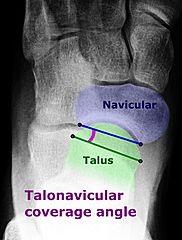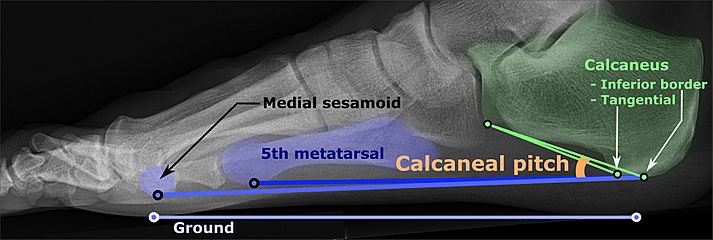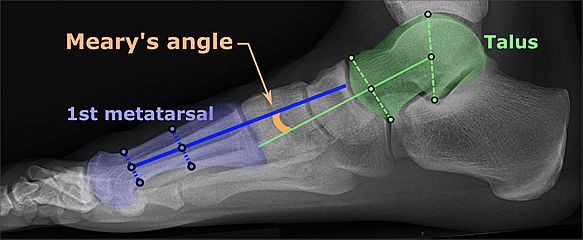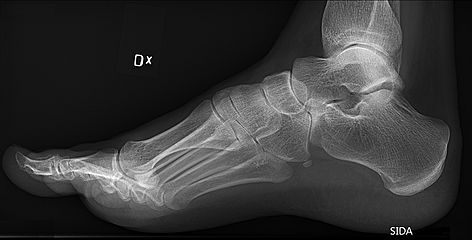Pes cavus facts for kids
Quick facts for kids Pes cavus |
|
|---|---|
| Synonyms | High instep, high arch, talipes cavus, cavoid foot, supinated foot |
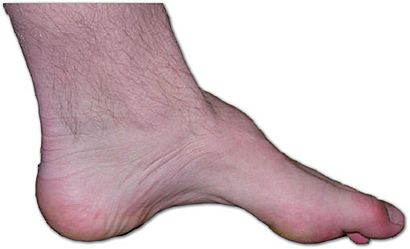 |
|
| High arch in foot of a person with a hereditary neuropathy | |
Pes cavus, also called a high arch, is a type of foot where the bottom of your foot looks very hollow when you stand on it. This means your foot is always bent downwards a bit. A high arch is the opposite of a flat foot, and it's not as common.
Contents
What is Pes Cavus?
Your foot has natural arches that help you walk, run, and jump. These arches act like shock absorbers. With pes cavus, the main arch in the middle of your foot is much higher than usual. This can make your foot feel stiff and less able to absorb shocks when you move.
Signs and Symptoms of High Arches
Foot Pain and Discomfort
Sometimes, people with high arches might feel pain in their feet. This can happen because the bones in the front of the foot (called metatarsals) get squished. However, not everyone with high arches has pain. Some people have flexible high arches that don't cause any problems at all!
People with high arches might find it hard to find shoes that fit well. They often need special support inside their shoes, called insoles or orthotics. These can help cushion the foot and spread out the pressure. Children who have trouble walking because of high arches can get custom-made insoles.
Common places where pain might occur include the ball of the foot, the heel, or the ankle. Some people might also get painful calluses (hard skin) on the bottom of their feet.
Other Related Issues
Having high arches can sometimes lead to other issues. These might include:
- Difficulty finding comfortable shoes.
- Ankles feeling unstable or easily twisting.
- Stress fractures in the lower leg (tiny cracks in bones from repeated stress).
- Knee or back pain.
- Tripping more often.
The pain often comes from how pressure is put on the foot. A high-arched foot is usually stiff and doesn't absorb shock very well. This means less of the foot touches the ground, putting more pressure on certain spots.
What Causes High Arches?
High arches can be something you are born with (hereditary) or something you develop later (acquired). The cause can be related to your nerves, bones, or muscles and nerves.
Genetic Causes
Sometimes, high arches are linked to certain genetic conditions. One common condition is Charcot-Marie-Tooth disease, often called CMT. This disease affects the nerves that control your muscles. It can make muscles weak, especially in the feet and lower legs, leading to foot deformities like high arches.
CMT is a common inherited nerve disease, affecting about 1 in 2,500 people. It can start at any age, from childhood to adulthood. CMT usually affects the feet first, causing weakness, clumsiness, and frequent falls. It can cause painful foot problems. Unfortunately, there is no cure for CMT right now.
In CMT, the muscles around the foot and ankle can become unbalanced. Some muscles become weaker, while others stay strong. This imbalance can pull the foot into a high-arched shape.
Other Causes
Not all high arches are caused by nerve problems. Some can be due to:
- Muscle weakness or imbalance from other conditions.
- Effects from a clubfoot at birth.
- Bone problems after an injury.
- Tightness in the tissues on the bottom of the foot (plantar fascia).
- A short Achilles tendon (the tendon at the back of your heel).
If there's no clear reason like a nerve problem, injury, or birth defect, the cause of high arches is called 'idiopathic,' meaning it's unknown.
How Doctors Diagnose High Arches
Doctors can diagnose high arches by looking at your foot and how you stand. They might also use X-rays to get a clearer picture of your foot bones.
On an X-ray, doctors look for specific signs. For example, they might measure angles between certain bones, like the talus and the first metatarsal bone. These measurements help them understand the shape and severity of the high arch.
Different Types of High Arches
High arches can look different from person to person. Doctors describe three main types:
- Pes cavovarus: This is the most common type. It's often seen in conditions like Charcot-Marie-Tooth disease. In this type, the heel bone turns inward, and the front of the foot points downwards. The toes might also look like claws.
- Pes calcaneocavus: This type is less common and can happen if certain leg muscles are weak. Here, the heel bone is bent upwards, and the front of the foot is bent downwards.
- Pure pes cavus: In this type, the heel isn't turned inward or bent upwards. The arch is simply very high because the front of the foot is bent downwards compared to the back of the foot.
Sometimes, a person might have a mix of these types. High arches can also be flexible (meaning they can flatten out a bit when you don't put weight on them) or rigid (meaning they stay high all the time).
Treating High Arches
Most of the time, high arches can be managed without surgery. The main goal is to reduce pain and make walking more comfortable.
Non-Surgical Treatments
Doctors often suggest treatments that don't involve surgery first. These include:
- Foot orthoses: These are special inserts for your shoes (like insoles) that help support your arch and spread out the pressure on your foot.
- Cushioned footwear: Wearing shoes with good cushioning can help absorb shock and make walking more comfortable.
- Stretching and strengthening: Doing exercises to stretch tight muscles and strengthen weak ones in your feet and legs can be helpful.
- Physical therapy: A physical therapist can help with exercises, massage, and other techniques to improve foot function and balance.
Surgical Treatments
Surgery is usually only considered if a person has severe pain that doesn't get better with other treatments. Surgical procedures aim to correct the foot's shape and balance it better. These operations can be complex and involve:
- Soft-tissue procedures: These might involve releasing tight tissues on the bottom of the foot or lengthening the Achilles tendon.
- Osteotomy: This involves cutting and reshaping bones in the foot to improve its alignment.
- Bone-stabilizing procedures: In some cases, bones might need to be fused together to make the foot more stable.
How Common Are High Arches?
It's a bit hard to know exactly how many people have high arches because studies have shown different numbers. However, most studies suggest that about 10% of people in the general population have a high-arched foot.
History of the Term
The term pes cavus comes from Latin and means "hollow foot." It's also known by other names like "high-arched foot." This condition describes a foot deformity where the arch is unusually high. Often, the heel turns inward, the front of the foot points downwards, and the toes might curl. Even though doctors have known about high arches for a long time, there's still a lot to learn about the best ways to assess and treat them.
See also
 In Spanish: Pie cavo para niños
In Spanish: Pie cavo para niños
- Arches of the foot
- Foot type
- En pointe
- Foot binding
- Rocker bottom foot


